Catholic Plots (WJEC Eduqas GCSE History): Revision Note
Exam code: C100
Timeline
How serious were the Catholic plots to Elizabeth I's reign? Summary
The Catholic plots posed a significant threat to Elizabeth’s reign, as they aimed to overthrow her and restore Catholicism in England and Wales. Many Catholics did not accept Elizabeth as the rightful queen and supported Mary, Queen of Scots, with several plots seeking to replace Elizabeth with her. In addition, foreign powers such as Spain and France were also willing to support rebellions, increasing the danger.
However, the seriousness of these plots was reduced by the actions of Elizabeth’s government, particularly the work of Sir Francis Walsingham and his extensive spy network. Walsingham’s ability to uncover, infiltrate and prevent the plots before they posed a real danger to Elizabeth’s safety significantly limited their impact. As a result, none of the Catholic plots advanced far enough to place Elizabeth’s reign in any real danger.
Ridolfi Plot
The Aims of the Ridolfi Plot
Roberto di Ridolfi was an Italian Catholic banker
Ridolfi planned to depose Elizabeth with help from Spain
The Ridolfi Plot of 1571 aimed to:
Assassinate Elizabeth
Replace Elizabeth with Mary, Queen of Scots
Restore Catholicism

Events of the Ridolfi Plot
In March 1571, Ridolfi travelled to the Spanish Netherlands
He met with the Pope, Philip II, and the Duke of Alba
He had in his possession a signed letter from the Duke of Norfolk
The letter confirmed that Norfolk was a Catholic and would lead a rebellion against Elizabeth with Philip’s support
The meeting was a success for Ridolfi
He secured Philip’s support
Philip agreed to send the Duke of Alba and 10,000 men to England when Norfolk required them
Historians are unsure about how genuine this support was. Alba wrote to Philip that Spain should only send troops to England if Norfolk succeeded in overthrowing Elizabeth
Sir William Cecil uncovered Ridolfi’s plot in the Autumn of 1571
Norfolk’s servants betrayed the plan when under interrogation
Cecil also had evidence in the form of coded letters in the Duke of Norfolk’s house
The Duke of Norfolk was arrested in September 1571
Ridolfi’s plan was never enacted
Cecil foiled the plan before it began
Ridolfi was not in England when Cecil discovered the plot
He never returned to England, so he did not face the repercussions of his actions
Consequence of the Ridolfi Plot
In the short term, the Ridolfi Plot resulted in
Parliament demanded the punishment of the Duke of Norfolk and Mary, Queen of Scots
The Duke of Norfolk was put on trial for high treason, found guilty, and executed in June 1572
English Catholics smuggling priests into England and Wales
They hid them in secret hiding places called ‘priest holes’
Any priests found were hanged, drawn, and quartered
In the long term
Mary, Queen of Scots, remained a threat to Elizabeth
Elizabeth refused to execute her
Mary was still in consideration for the royal succession
Spain continued to be a threat to England and Wales
Elizabeth and her government believed that Spain wanted to destroy Protestantism across Europe
Elizabeth sought a better relationship with France to protect herself from Spain
Throckmorton Plot
Aims of the Throckmorton Plot
Francis Walsingham, Elizabeth’s spymaster, heard rumours of a plot between:
Scottish Jesuits
Mary Queen of Scots
The Spanish Ambassador de Mendoza
The link between these individuals was Francis Throckmorton, a young English Catholic
Throckmorton was planning to:
Overthrow Elizabeth
Replace Elizabeth with Mary Queen of Scots
Restore Catholicism to England

Events of the Throckmorton Plot
Historians know very little about how the plan began. This is because:
The plotters destroyed many of their letters to conceal evidence of their scheming
The government used torture to extract confessions from the plotters
They may have said what they believed the interviewer wanted to hear to avoid further punishment
The government placed Throckmorton under surveillance in April 1583
Throckmorton’s regular visits to Mendoza aroused the government’s suspicions
Francis Walsingham did not act straight away
He wanted to obtain enough evidence to charge Throckmorton with treason
He needed to determine who was conspiring with Throckmorton and Mary, Queen of Scots’ involvement in the plan
In June 1583, Walsingham searched Throckmorton’s house
The papers at Throckmorton's house showed communication with multiple Catholic nobles in England
Throckmorton had been researching which harbours were suitable for an invasion force to land
Elizabeth’s government arrested Throckmorton in November 1583
Throckmorton stated the plot had gone no further than the planning stage
This was because Throckmorton was waiting for the money promised by Philip II
Both Throckmorton and Mary, Queen of Scots, retracted their confessions
They stated that the investigators used torture
This forced them to make false statements of guilt
Consequences of the Throckmorton Plot
In the short term
Throckmorton was charged with treason and executed in May 1584.
Elizabeth expelled the Spanish ambassador, Mendoza, from her court
Mary, Queen of Scots, faced no punishment
However, she was moved to Tutbury Castle and placed under house arrest
Lord Henry Howard and Henry Percy were both arrested
Percy took his own life in the Tower of London
Lord Howard was released without charge
In the long term
Many Catholics fled from England and Wales
Over 11,000 Catholics were arrested or kept under surveillance
Elizabeth and her government passed another Act of Parliament in 1585
Stating that any subject who helped or sheltered Catholic priests would face the death penalty
Babington Plot
Aims of the Babington Plot
In 1586, a young Catholic called Anthony Babington plotted to kill Elizabeth
Babington aimed to restore Catholicism to England by:
Killing Elizabeth
Rescuing Mary Queen of Scots
Placing Mary Queen of Scots on the throne

Babington needed to know if Mary would support the plot
Babington planned to write to Mary to seek her interest
Events of the Babington Plot
In July 1586, Babington wrote to Mary explaining his plot
Francis Walsingham, Elizabeth’s spymaster, monitored Mary closely after the Throckmorton Plot
Walsingham wanted to catch Mary in the act of plotting
This would give Elizabeth the evidence needed to punish Mary
His spy network was intercepting Mary’s outgoing and incoming letters
Walsingham cracked the cypher that Babington and Mary used in their letters. He could use the cypher to decode the letters
Walsingham placed spies within Mary’s household
They persuaded Mary that it was safe to communicate in secret letters
Mary placed the letters in beer barrels
Walsingham allowed Babington’s plot to develop
He wanted enough evidence to incriminate Mary in treason
He was waiting for Mary to send a letter that showed her full involvement in Babington’s plan
He needed to know the names of every Catholic accomplice in the plot
On 17th July 1586, Walsingham uncovered the evidence needed to prove Mary’s guilt
Mary wrote a letter to Babington
This letter is known as the ‘Gallows Letter’
Historians call this the ‘Gallows Letter’ because it ‘proved’ Mary’s guilt in treason and would result in her execution
Mary wrote to Babington that:
“Then shall it be time to set the six gentlemen to work”
The ‘six gentlemen’ were the men Babington chose to assassinate Elizabeth
Historians accept that this shows Mary’s knowledge of the plot against Elizabeth
The Gallows Letter does not state Mary’s agreement to the plot
Babington learnt that the government had uncovered the plot
The government attempted to arrest Babington
Babington and two of his accomplices attempted to flee
Babington was eventually caught in Middlesex
Walsingham presented the evidence of Mary’s scheming to Elizabeth
Consequences of the Babington Plot
In the short term
Babington was captured and charged with high treason
In September 1586, Babington and his accomplices were hanged, drawn and quartered
Mary, Queen of Scots, was moved to Fotheringhay Castle, Hampshire
She was placed on trial for treason and found guilty
In the long term
Elizabeth forced harsher punishments on English Catholics
She arrested 300 recusants in London
She executed 31 Catholic priests
By 1586, England and Spain were effectively at war
Elizabeth sent soldiers to the Netherlands to help the Protestant rebels
The prosecution of Mary, Queen of Scots, worsened relationships and caused Spain to depose Elizabeth
The Trial and Execution of Mary, Queen of Scots

Upon the discovery of Mary’s involvement, Elizabeth had to decide how to proceed with Mary Queen of Scots
Members of her Privy Council were demanding her execution
The Catholic threat continued, despite harsh laws
In October 1586, Mary Queen of Scots was put on trial for treason
Mary Queen of Scots was found guilty by 36 Noblemen
She was sentenced to death on 25th October 1586

Despite Elizabeth’s initial concerns, Mary’s death warrant was signed by Elizabeth on 1st February 1587
Mary was executed at Fotheringhay Castle on 8th February 1587
Did the execution of Mary Queen of Scots end the Catholic threat in England?
Although Mary Queen of Scots was no longer a possible Catholic heir to the English throne, she remained a threat even in death
English Catholics now had a martyr
Elizabeth was seen by some Catholics as a heretic who killed Catholic queens
Elizabeth showed the world that queens could be executed
This was potentially a dangerous idea to show to the Catholics of England
Scottish and French kings were outraged
However, they did not act against Elizabeth
King Philip II of Spain was furious at Elizabeth
This caused Philip to speed up his plans for the Spanish Armada
Despite these issues, after the execution of Mary, Queen of Scots, there were no more Catholic plots against Elizabeth
Many Catholics lost hope of a Catholic restoration with Mary’s death
Approximately 10% of the population was Catholic
Most people saw Catholicism as not English
Examiner Tips and Tricks
In this exam, question 4 will ask you to explain the connections between three out of four features. For example, it may ask you to ‘Explain the connections between two of the following that are to do with Catholic threats:
The rebellion of the Northern Earls
The Ridolfi Plot
The Throckmorton Plot
The Babington Plot
To achieve the higher bands, you must explain the connections between all three features, not just a single link.
Worked Example
What can be learnt from Sources A and B about the Babington Plot?
Source A
“We... will undertake the delivery of your royal persons from the hands of your enemies... For the dispatch of the usurper (Elizabeth)... six noble gentlemen, who, for the zeal they have to the Catholic cause... will undertake that tragical execution.”
[An extract from a letter written by Anthony Babington to Mary, Queen of Scots, in July 1586]
Source B

[4 marks]
Answer:
The sources show that the Babington Plot aimed to remove Elizabeth I and place Mary, Queen of Scots, on the throne and that secret coded letters were involved in the plot. Source A shows that Anthony Babington and the other plotters planned to free Mary from her house arrest and promised to assassinate Elizabeth I (1). Source A also shows that six Catholic members of the nobility were involved in the plot to kill Elizabeth I (1). Source B shows that the cypher used by Mary I in her letters to Babington, suggesting that the communication between Mary and Babington was secret, and they used it to hide their communication from people spying on them (1). Source B also shows that Mary was actively involved in a plot to kill Elizabeth I, and not just named by Catholic plotters in their attempts to remove Elizabeth I from the throne (1).

Unlock more, it's free!
Did this page help you?